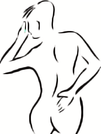Osteopathy is a system of diagnosis and treatment whose philosophy relies upon a knowledge of the structural mechanics of the body. It is concerned with function and the role of the musculoskeletal system as the originator of problems or the reflection of total body health in general. The balance and relationship between skeletal structures and organ systems is paramount for normal health to preside as there is an intrinsic interdependence between the two (& the relationship between the psyche and the soma has always been known to be of great importance but it is more recently that research is giving even greater insights). The whole body relies upon innate self-regulating feedback mechanisms which keep or restore balance as an essential ongoing dynamic process (The greek word for this is homeostasis or allostasis).
Osteopaths try to look at the vulnerability of the individual to dysfunction or illness and the wide variety of factors that are always at play: These include posture, work stress, ergonomics, repetitive activities, faulty movement patterns, previous injury etc..
Osteopaths are trained to recognise conditions which require referral to a G.P or for further investigations and as such all treatment is based upon sound training, good provisional diagnosis which requires the taking of a complete medical history allied with examination and certain orthopaedic tests. We use palpation to assess tissues for temperature, tone, shape, mobility (motility) and general integrity in order to formulate an appropriate treatment program. The patient will also be given advice and usually prescribed carefully constructed exercises to help with rehabilitation at the appropriate time. (Most patients presenting with pain have problems in both the tissues that are obviously symptomatic as well as areas which are not actually painful but may be contributing to the underlying problem itself; this is often due to mechanical compensation or pain radiation patterns. Some conditions can refer pain from the viscera {organs} to other areas which osteopaths are trained to recognise).
The development of this radical (at the time) philosophy and therefore treatment modality has its roots in America in and around 1874. Dr Andrew Taylor Still, the son of a methodist preacher, became increasingly disgruntled with the heroic remedies employed in those days, which often caused more harm than good. As a result he began to formulate a system of medicine which laid most of the emphasis on the innate self-repairing qualities of the human physiology itself. Evolutionary processes are the innate drivers involved in living organisms abilities to deal with the environment. Using largely mechanical techniques, the full potential for natural self-healing as he invisaged could be unleashed. There were no pain-killing drugs, scans or blood tests in those days and germ theory (Lister and Pasteur) was virtually unheard of, with many surgical patients dying from post-operative infections having survived the actual surgery itself. Today many prescription and over the counter drugs whilst offering tested benefits still have unwanted side-effects some of which are given rather light press coverage for one reason or another.
Most of the key tenets of osteopathy were formulated at this time (late 1800s) and remain the bedrocks of modern osteopathy. Today osteopathy is practised in light of modern medical research (which because of its reductionist, Cartesian basis or/& emphasis doesn`t always represent a good descriptor for osteopathy in practice) which has made advancements in many fields with the development of revolutionary drugs, vaccinations treatments and scans. (ng59 guidelines based upon systematic reviews). Osteopaths try to reach some of the underlying causes of ill health by understanding the context of an individual's symptoms such as pain as representing a wider problem.
© RDI ltd 2020 I
Abingdon Osteopath.com
Diagnosis | Prognosis | Treatment | Pain Relief | Maintenance | Prevention
To Make An Appointment
Please Telephone
01491 838 866
07788 421890

